British and European Car Spotters Guide - 1946 |
|
|
 |
|
|
|
The war hardly over, and bugger all left of the one testicled twerp from Austria, save for a badly burnt jaw held by Stalin. UK car manufacturers wasted no time in reverting to civilian production. Most cars were carry-overs from 1939/40, but there were some new models. Newly produced cars in 1945 were at first delivered only to essential users; later they could be acquired only against a permit issued by the Ministry of War Transport The basic ration of petrol was restored, enabling pleasure motoring to be resumed on a basis of about 200 miles per month.
New car prices were high and included the new Purchase Tax. Faced with the urgent need for stimulating export, the Government required the motor industry to export half of their production of cars and one-third of new commercial vehicles. Cars, buses and trucks could be sold almost anywhere, particularly in war-torn Western Europe. North America was ready for large numbers of sports cars, and firms such as MG could not produce enough to meet the demand. Car production in 1945 and 1946 totalled 16,938 and 219,162 respectively. By the beginning of 1946 some 11 million cars were in use in the UK. |
 |
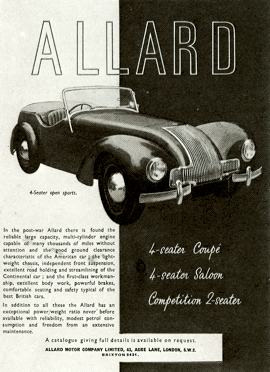 |
 |
Allard |
| |
Also see: Allard Car Reviews | The History of Allard |
| |
Allard cars were powered by developed versions of the well-known Ford V8 3·6-liter engine. In this advertisement is the Model L open four-seater, which had a wheelbase of 9 ft 4 in. Sydney Allard was a well-known participant in pre-war trials and speed events, using Ford-based Specials of his own design. Quantity production of post-war Allard cars commenced in 1946. and during the ensuing years a large variety was produced, many finding their way to North America in chassis form (to be fitted with Cadillac and other V8 engines). The body design was partly the work of Godfrey Imhof, another well-known rally and trials driver. |
|
 |
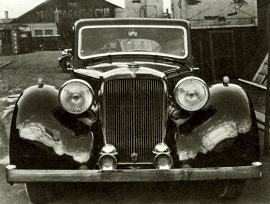 |
 |
Alvis Fourteen TA 14 Saloon |
| |
Also see: Alvis Car Reviews | The History of Alvis |
| |
The Alvis Fourteen TA 14 Saloon was the Company's only model in production during 1946. It was a new and beautifully proportioned four-door four-light model, powered by a four-cylinder 1892-cc (74 x 110 mm) OHV engine, driving through a four-speed gearbox. Wheelbase was 9 ft tire size 6.00-16.
|
|
 |
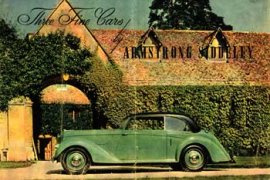 |
 |
Armstrong Siddeley Typhoon |
| |
Also see: The History of Armstrong Siddeley |
| |
Armstrong Siddeley started post-war production in November 1945 with the 16 HP Lancaster Saloon and Hurricane Drophead Coupe, supplemented by the Typhoon Two-door Saloon from August 1946. They remained in production until September 1949, when the engine was uprated. 1945-49 models had a 1991cc (65 x 100 mm) 70-bhp OHV power unit. Wheelbase was 9 ft 7 in, tire size 5.50-17. Pre-production Lancaster and Hurricane cars had made their debut as early as May 1945-during the same week as VE Day (Victory in Europe). |
|
 |
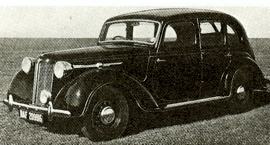 |
 |
Austin Sixteen Model BS1 |
| |
Also see: Austin Car Reviews | The History of Austin (AUS Edition) |
| |
Austin Sixteen, Model BS1, was new in the Company's immediate post-war programme. This car was basically the same as the Twelve (HS1), but instead of a 1535cc side-valve engine it had a new 2199-cc overhead-valve unit with an output of 58 bhp at 3700 rpm. The RAC rating was 15·99 HP. Automatic reversing light, built-in hydraulic jacks and heater were standard equipment on the Sixteen. The saloon illustrated was delivered to the RAF. Post-war production of the 8, 10,12 and 16 HP Saloons started in August 1945 and ceased in October 1947, with the exception of the 16 HP, which was continued until early 1949. In June 1946, the millionth car came off Austin's Longbridge assembly line. It was a Sixteen, finished in matt cream. |
|
 |
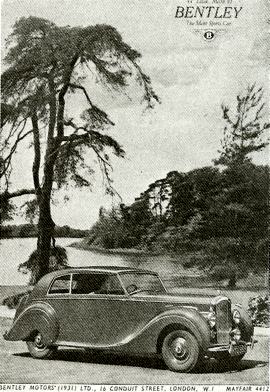 |
 |
Bentley Mark VI Saloon |
| |
Also see: Bentley Car Reviews | The History of Bentley |
| |
Post war production for Bentley commenced in May, 1946, with the Mark VI Saloon. Other body styles were also offered, as well as the bare chassis for specialist coachwork. The engine was a six cylinder F-Head overhead inlet, side exhaust 29·4 HP unit of 4257cc cubic capacity with twin SU carburetors and four speed gearbox. Wheelbase was 10 ft., tire size 6.50-16. It was continued in this form until September 1951, when a larger bore 4566cc engine was introduced.
|
|
 |
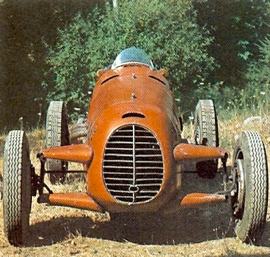 |
|
 |
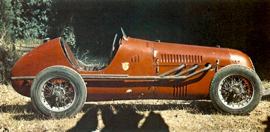 |
|
 |
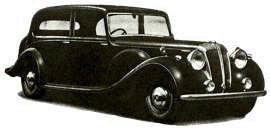 |
 |
Daimler Straight Eight Model DE36 |
| |
Also see: Daimler Car Reviews | The History of Daimler (AUS Edition) |
| |
The Daimler Straight Eight Model DE36 was available in chassis and Limousine form. It was the largest Daimler available and the eight-cylinder 5460-cc engine had the same cylinder dimensions (85·09 x 120 mm) as the 4095cc six-cylinder Model DE27. Both were OHV engines. with twin SU carburetors, producing 110 and 150 bhp respectively. Front suspension was independent wheelbase 12 ft 3 in and 11 ft 6½ in respectively. Production started in March.
|
|
 |
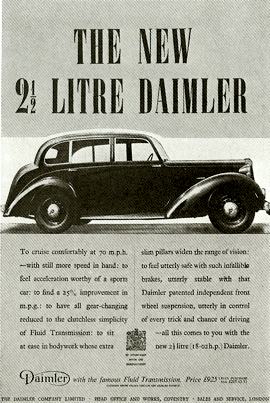 |
 |
Daimler 2½-liter Model DB18 |
| |
Also see: Daimler Car Reviews | The History of Daimler (AUS Edition) |
| |
The Daimler 2½- liter Model DB18 was introduced in February 1946. It was available in chassis form. with drophead coupe bodywork and as a four-door saloon (shown). The engine was a 2522cc 70-bhp OHV Six. driving through a fluid flywheel and pre-selector epicyclic gearbox and worm drive rear axle. Front suspension was independent with coil springs.
|
|
 |
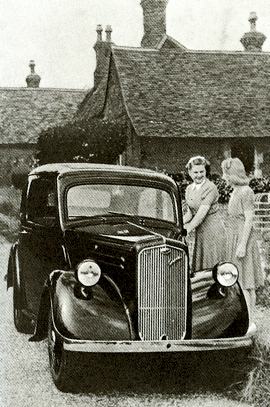 |
 |
Ford Anglia 8HP Model E04A |
| |
Also see: Ford UK Car Reviews | The History of Ford |
| |
The Ford Anglia 8 HP Model E04A was a carry-over from 1939/40 albeit with some detail improvements and modifications. Post-war production started in October 1945. The four-cylinder side-valve engine was of 933cc capacity, having a bore and stroke of 56·6 x 92·5 mm. With 6·3:1 CR it developed 23-4 bhp. Gearbox was three-speed. wheelbase 7 ft 6 in. tire size 450-17. It remained virtually unchanged until late in 1948. |
|
 |
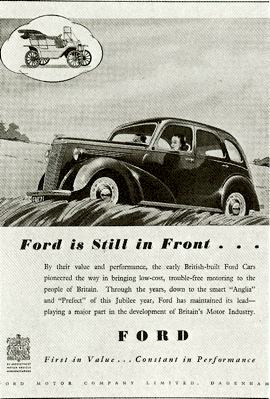 |
 |
Ford Prefect 10 HP Model E93A |
| |
Also see: Ford UK Car Reviews | The History of Ford |
| |
The Ford Prefect 10 HP Model E93A was put into production in October 1945. It was fundamentally the same as produced in 1939/40 and differed from the Anglia chiefly in the following respects: four-door bodywork with different front and rear end. 7 ft 10in wheelbase, 12 ft 11¼ in (v. 12 ft 8¼ in) overall length. 5.00-16 tires and 63·5-mm cylinder bore, giving 1172-cc cubic capacity. Maximum power output with 6·16:1 CR. was 30 bhp. The millionth vehicle to emerge from Ford's Dagenham plant (opened in 1931) was a white Prefect in August 1946. It was driven from the assembly line by the Minister of Supply. Mr John Wilmot. |
|
 |
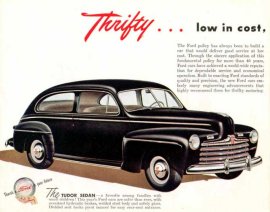 |
|
 |
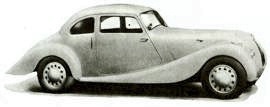 |
 |
Frazer-Nash-Bristol 2-liter |
| |
Also see: The History of Frazer-Nash |
| |
The Frazer-Nash-Bristol 2-liter was announced in 1946, although quantity production did not commence until 1947, by which time it was known as the Bristol 400. The car was developed by the Bristol Aeroplane Company in conjunction with Messrs Adlington of AFN Ltd. producers of the Frazer-Nash- BMW. The latter was basically the pre-war German BMW 328, and the engine of the new car was developed by Bristol during 1945-1946, also from the BMW 328. It was a 1971cc OHV Four with three SU carburetors. The new car had a well-streamlined four-seater body on a massive-looking but light box girder frame, with a wheelbase of 9 ft 6 in. IFS with transverse leaf spring and torsion bar rear springing.
|
|
 |
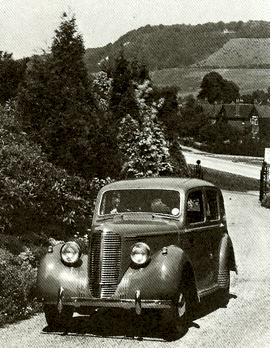 |
 |
Hillman Minx |
| |
Also see: Hillman Car Reviews | The History of Hillman (AUS Edition) |
| |
The Hillman Minx was reintroduced in 1945, and Hillman claimed, no fewer than 57 improvements compared with the 1940 model, to which it looked identical. The price, in October 1946, was £442 and a Drophead Coupe was available at £525, both prices inclusive of PT.
|
|
 |
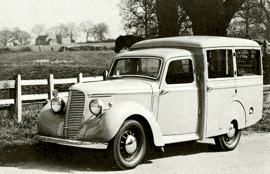 |
|
 |
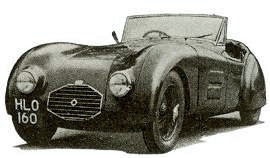 |
 |
HRG 1100 and 1500 |
| |
|
| |
HRG offered two Sports Two-Seaters, the 1074-cc 1100 and the 1496-cc 1500 (shown). They were similar in appearance, but apart from the 44 and 61 bhp engines, differed slightly in dimensions, the wheelbase being 8 ft 4½ in and 8 ft 7½ in respectively. Both engines were based on Singer units, with overhead camshaft and twin SU carburetors. The cars were made in small numbers by HRG Engineering Co. in Tolworth, Surrey.
|
|
 |
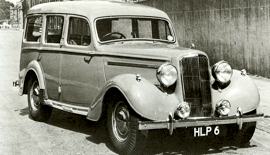 |
 |
Humber Super Snipe Estate / Van |
| |
Also see: Hillman Car Reviews | The History of Hillman (AUS Edition) |
| |
Humber Super Snipe with attractive Estate Car coachwork. This was not a regular production body style but a special vehicle bodied by Thrupp & Maberly. Note the 'boot scrapers' below the doors.
|
|
 |
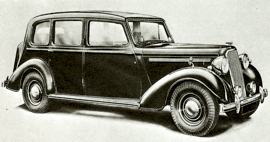 |
 |
Humber Pullman |
| |
Also see: Hillman Car Reviews | The History of Hillman (AUS Edition) |
| |
The Humber Pullman was mechanically similar to the Super Snipe, but had 12-in v. 11-in Lockheed hydraulic brakes and 10ft 7½ in v. 9 ft 6 in wheelbase. It could carry seven passengers and driver. The 4-liter side-valve Six engine developed 100 bhp at 3400 rpm. All Humbers had independent front suspension with wishbones and transverse leaf spring.
|
|
 |
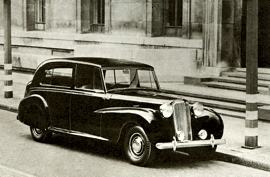 |
 |
Humber Pullman |
| |
Also see: Hillman Car Reviews | The History of Hillman (AUS Edition) |
| |
The Humber Pullman with special luxurious Sedanca De Ville coachwork built to special order by H. J. Mulliner & Co. Ltd, for Rootes Ltd. With the main exception of the radiator grille, all the bodywork was different from the regular Pullman Limousine. It is shown here with the front compartment roof section removed and installed. The Motor wrote 'The bodywork is a good example of compromise between British and American styling, the car having flowing lines without over-exaggeration'. The price of the car was £2300, plus PT (November 1946).
|
|
 |
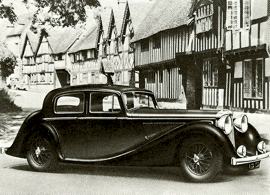 |
 |
Jaguar 1½, 2½ and 3½ liter Sports Saloons |
| |
Also see: Jaguar Car Reviews | The History of Swallow Sidecars |
| |
Jaguar Cars Ltd (formerly SS Cars Ltd., a name changed for obvious reasons) re-entered the post-war market with basically unchanged 1½, 2½ and 3½ liter Sports Saloons. There were several detail improvements. Except for certain features of equipment. the same style of coachwork was used for all three cars. The 1½ liter was a Four (73 x 106 mm) ; the others were Sixes (73 x 106 and 82 x 110 mm), all with OHV. |
|
 |
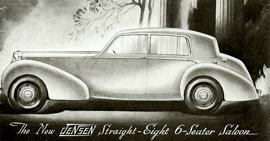 |
 |
Jensen Straight Eight Saloon |
| |
Also see: Jensen Car Reviews | The History of Jensen |
| |
The Jensen Straight Eight Saloon was a beautifully-styled high-performance car intended for the luxury market. The engine was a 130-bhp 3860cc (85 x 85 mm) 36·5 HP OHV 8-in-line with two SU carburetors, driving through an overdrive-top four-speed gearbox. Although announced in the summer of 1946, it was not until early 1948 that series production actually got under way. This advertisement appeared in September 1946. |
|
 |
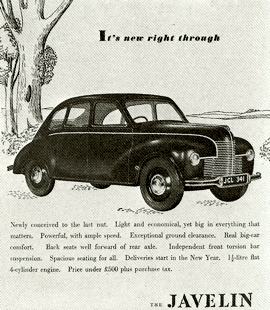 |
 |
Jowett Javelin |
| |
Also see: Jowett Car Reviews | The History of Jowett |
| |
The Jowett Javelin was first announced in mid-1946 and went into quantity production in the following year. It was an entirely new car, bristling with unusual design features. The horizontally-opposed fourrcylinder water-cooled OHV engine was mounted ahead of the front wheel axis. It was of 1486-cc cubic capacity (72·5 x 90 mm) and with a CR of 7·25:1 and two Zenith carburetors produced 50 bhp. Top speed was nearly 80 mph, fuel consumption averaging between 25-30 mpg. Drive was to the rear wheels via a steering column-controlled four-speed gearbox and divided propeller shaft. |
|
 |
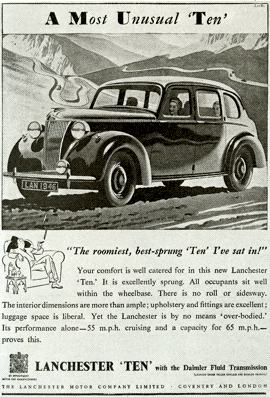 |
 |
Lanchester Ten, Series LD10 |
| |
Also see: The History of Lanchester |
| |
The Lanchester Ten, Series LD10, was produced from February 1946 until July 1951, although 1950/51 models had restyled bodywork (four-light by Barker). The engine, a 40-bhp OHV Four of 1287cc, was one of the most powerful Tens of the day. It drove through a fluid flywheel with pre-selector gearbox. Wheelbase was 8 ft 3 in, tire size 5.25-16. |
|
 |
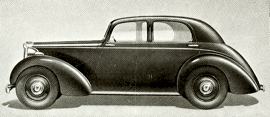 |
 |
Lea-Francis 12 and 14 HP |
| |
Also see: The History of Lea-Francis |
| |
The Lea-Francis 12 and 14 HP models of 1946 were similar in principle to the pre-war cars but considerably modified in detail. In addition to the four-light Saloon (shown) there was a Utility/estate car. A Coupe was added early in 1947 and a short-wheelbase Sports model in 1948. 12 and 14 had 100-mm stroke and 69 and 75-mm bore respectively, giving 1496 and 1767cc cubic capacity. Both were OHV Fours with two high-positioned camshafts and hemi-spherical combustion chambers. 1947 saloons had deeper side windows, whereby the 'upper waistline' was eliminated. |
|
 |
 |
 |
Lea-Francis Chassis |
| |
Also see: The History of Lea-Francis |
| |
Lea-Francis chassis was underslung at the rear and had 9 ft 3 in wheelbase and 5.50-17 tires. Suspension was conventional with rigid axles and semi-elliptic leaf springs front and rear. Brakes were Girling mechanical. |
|
 |
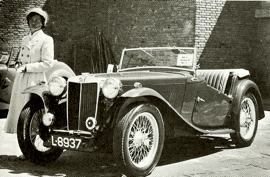 |
 |
MG Midget TC |
| |
Also see: MG Car Reviews | The MG Story |
| |
The MG Midget TC was produced from November 1945 until December 1949, during which period the impressive total of about 10,000 were made. A large proportion of these were exported, notably to North America. The TC resembled the 1939 TB in all but relatively minor respects. The body was four inches wider, the instrumentation was revised. a new synchromesh gearbox was fitted and the roadsprings had shackles rather than the previous sliding trunnions. Engine was 54-4-bhp 1250-cc four-cylinder with twin SUs. Wheelbase was 7 ft 10 in. tire size 450-19. |
|
 |
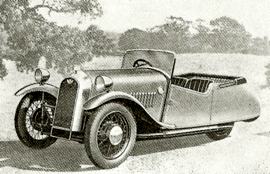 |
 |
Morgan F-4 |
| |
Also see: Morgan Car Reviews | The History of Morgan |
| |
The Morgan F-4 was a four-seater three-wheeler with 933cc 22-bhp four-cylinder side-valve Ford Eight engine. Transmission was by shaft from flywheel through centre bearing (obviating shaft whip) to three-speed gearbox, then to worm and wheel with single-chain final drive. Wheelbase was 8 ft 3 in, basic price £235 (August 1946). |
|
 |
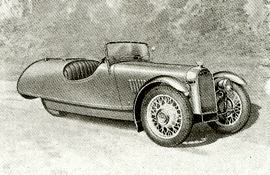 |
 |
Morgan F Super |
| |
Also see: Morgan Car Reviews | The History of Morgan |
| |
The Morgan F Super was basically similar to the F-4 but with a shortened wheelbase (7 ft 11 in), 1172cc Ford Ten engine and twooseater bodywork. It had a maximum speed of over 70 mph and could cruise at 65 mph. The basic price was £260. |
|
 |
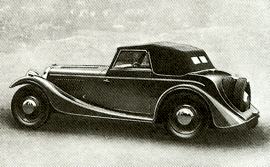 |
 |
Morgan 4/4 Drophead Coupe |
| |
Also see: Morgan Car Reviews | The History of Morgan |
| |
The Morgan 4/4 Drophead Coupe had a 38·8-bhp 1267cc OHV four-cylinder engine, specially made by the Standard Motor Co and rated at 9·99 HP. The gearbox had four speeds and Girling brakes were fitted. The two-seater bodywork had luggage accommodation inside the folding hood; the car carried two spare wheels. Wheelbase was 7 ft 8 in, overall height 4 ft 3 in. A two-seater Roadster and four-seater Tourer were also offered. |
|
 |
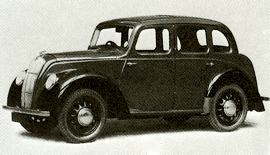 |
 |
Morris Eight Series E and Ten |
| |
Also see: Morris Car Reviews | Morris Production Details 1939/1950 |
| |
The Morris 1946 models were carry-overs from 1939/40 and comprised Eight, Series E, two and four-door Saloons and Ten four-door Saloons, all with fixed or sliding roof. Illustrated is a four-door Eight with sliding roof, which was priced at £300 plus just over £84 PT. Post-war production of the Eight had commenced in October 1945, in two-door form, the four-door being added in January 1946. Both had 7 ft 5 in wheelbase, 4.50-17 tires. |
|
 |
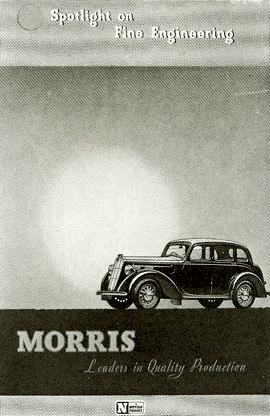 |
 |
Morris Ten |
| |
Also see: Morris Car Reviews | Morris Production Details 1939/1950 |
| |
The Morris Ten, Series M was reintroduced in September 1945, although it had been in production during the war years in military Light Utility form. The car was available only with four doors, with or without a sliding roof. Engine capacity was 1140 cc (Eight: 918·6 cc), maximum brake horsepower 37·2 (Eight: 29·6). Unlike the Eight. the Ten had overhead valves. Suspension was conventional with longitudinal leaf springs all round. Wheelbase was 7 ft 10in, tire size 5.00-16. Later in the year a new rounded radiator grille was introduced. This model was also produced in India, named Hindustan. |
|
 |
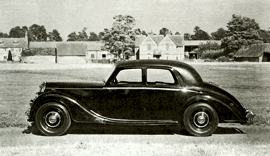 |
 |
Riley 15 HP |
| |
Also see: Riley Car Reviews | The History of Riley |
| |
Riley introduced an entirely new and most attractive post-war model in September 1945. The engine was not much different from that of the pre-war 1½- liter. The new chassis featured Torsionic IFS with torsion bars and the body, too, was of an entirely new design. In October 1946, a 2½- liter model was added which had a longer bonnet and a pale blue instead of a dark blue radiator badge. Cubic capacities of the engines were 1496 and 2443cc respectively. Wheelbase was 9 ft 4½ in for the 1½- liter, 9 ft 11 in for the 2½- liter. |
|
 |
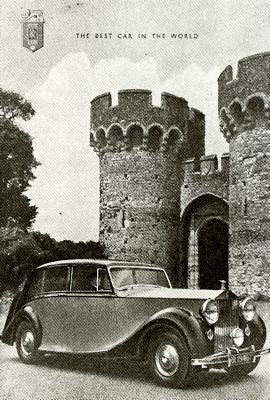 |
 |
RolIs-Royce Silver Wraith 4½-liter |
| |
Also see: Rolls-Royce Car Reviews | The History of Rolls-Royce |
| |
The RolIs-Royce Silver Wraith 4½-liter was produced during 1946-1951, had a six-cylinder 4257cc (88·89 x 114·3 mm) 29·4 HP 126-bhp engine with twin-choke Stromberg carburetor and 6·4:1 CR. It had overhead inlet and side exhaust valves (F-head type). Gearbox was four-speed, wheelbase 10ft 7 in. Several body styles were offered. |
|
 |
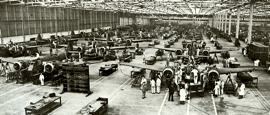 |
 |
Rootes Airframe Factory, Speke, Liverpool |
| |
Also see: The History of Rootes (AUS Edition) |
| |
The headquarters of the British Motor Industry, 148 Piccadilly. London. W1, decorated for the Motor Industry's Jubilee celebrations. These premises were officially opened by the Rt. Hon. John Wilmot MP, Minister of Supply, on 18 July 1946. He also opened the Jubilee Exhibition. which was housed in the same building. |
|
 |
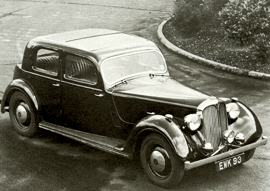 |
 |
Rover Ten, Twelve, Fourteen, Sixteen and Speed |
| |
Also see: Rover Car Reviews | The History of Rover (AUS Edition) |
| |
Rover offered Ten, Twelve, Fourteen and Sixteen Saloons. The latter three were also available with Sports Saloon bodywork (Twelve shown). This body style was a little less in height and had four side windows instead of six. providing a more lengthy appearance The Twelve had a 1496cc OHV Four engine and 9 ft 4 in wheelbase. |
|
 |
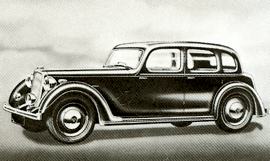 |
 |
Rover Fourteen Saloon |
| |
Also see: Rover Car Reviews | The History of Rover (AUS Edition) |
| |
Rover Fourteen Saloon with six-light bodywork. It was similar to the Sixteen, the main exception being the cubic capacity of the six-cylinder OHV engines, 1901 and 2174cc respectively. Model shown cost £812, as four-light Sports Saloon £831. |
|
 |
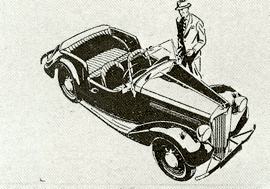 |
 |
Singer Nine Roadster |
| |
Also see: Singer Car Reviews | The History of Singer |
| |
The Singer Nine Roadster appeared in May 1946. It had aluminum-panelled four-seater bodywork, a 1074cc (60 x 95 mm) OHC engine with one SU carburetor, three-speed gearbox and 7 ft 7 in wheelbase. It was continued until late in 1949, when a Solex carburetor, a four-speed gearbox and other detail modifications were introduced. Price £493. |
|
 |
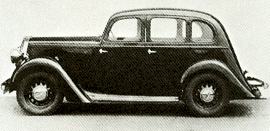 |
 |
Singer Super Ten |
| |
Also see: Singer Car Reviews | The History of Singer |
| |
The Singer Super Ten went into production in December 1945, and had an 1193cc (63·25 x 95 mm) 37-bhp OHC engine. In December 1946 the Super Twelve Saloon was added. It was similar to the Super Ten, but somewhat larger, and powered by a 43-bhp 1525cc (68 x 105 mm) engine, also with overhead camshaft. Wheelbase sizes were 7 ft 11 in and 8 ft 7 in respectively. |
|
 |
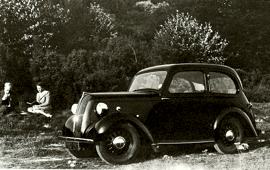 |
 |
Standard Eight Saloon |
| |
Also see: Standard Car Reviews | The History of Standard |
| |
The Standard Eight Saloon was substantially similar to the 1940 model, the main external difference being the omission of the louvres in the bonnet sides. A minor modification was that the transverse leaf spring of the front suspension was now anchored with six instead of four bolts. Also, the three-speed gearbox was replaced by a four-speed. |
|
 |
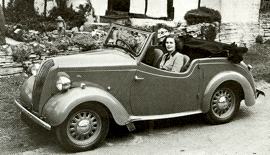 |
|
 |
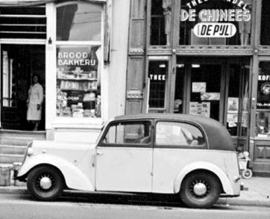 |
 |
Standard Twelve Utility |
| |
Also see: Standard Car Reviews | The History of Standard |
| |
The Standard Twelve Utility model was produced for export and was based on the military 12 HP chassis with beam type front axle.and semi-elliptic leaf springs (the only post-war Standard car without IFS). It also retained the rectangular military type instrument panel, set in a wooden dash panel. Below the rear window was a small bottom-hinged door, providing access to the loading space behind the (folding) rear seat. This door lid, when left open, formed a strong platform for long or additional loads. |
|
 |
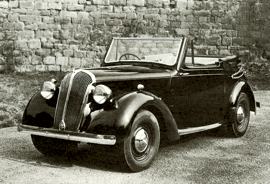 |
 |
Standard Twelve Drophead Coupe |
| |
Also see: Standard Car Reviews | The History of Standard |
| |
Standard Twelve Drophead Coupe. This 1609cc 11·98 HP chassis was also produced with four-door saloon bodywork. identical to that of the Fourteen. |
|
 |
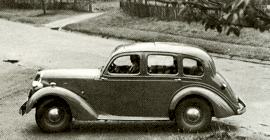 |
 |
Standard Fourteen Saloon |
| |
Also see: Standard Car Reviews | The History of Standard |
| |
The Standard Fourteen Saloon and Drophead Coupe were generally similar to the corresponding Twelve models but had a larger-bore 1776-cc 13·23 HP engine. Prices were the same, £479 for the Saloons. £505 for the Coupes. |
|
 |
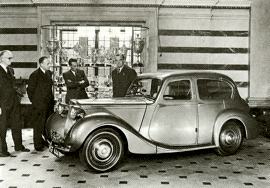 |
 |
Sunbeam-Talbot Ten Saloon |
| |
Also see: Sunbeam Car Reviews | The History of Sunbeam |
| |
The Sunbeam-Talbot Ten Saloon was same as in 1940 except for detail improvements including redesigned aluminum cylinder head. The 1185cc 41-bhp side-valve Four engine (derived from the Hillman Minx) drove through a four-speed gearbox and the Bendix Duo-Servo brakes were cable-operated. A Sports Tourer and a Drophead Coupe were also available. Prices were £684, £646 and £729 respectively (including PT). |
|
 |
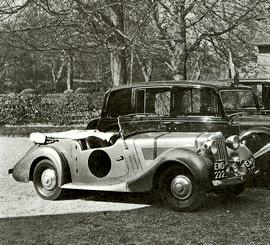 |
 |
Sunbeam-Talbot 2-liter Sports Tourer |
| |
Also see: Sunbeam Car Reviews | The History of Sunbeam |
| |
Sunbeam-Talbot 2-liter Sports Tourer. The 2-liter models (Saloon, Tourer and Drophead Coupe) had a 1944cc 56-bhp four-cylinder side-valve engine and 10-inch Lockheed hydraulic brakes. Both the Ten and the 2 liter were in production from July 1945 to June 1948. |
|
 |
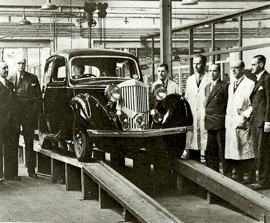 |
 |
Sunbeam-Talbot |
| |
Also see: Sunbeam Car Reviews | The History of Sunbeam |
| |
During 1946 Sunbeam-Talbot production was transferred by Rootes, the parent company, to Ryton-on- Dunsmore, near Coventry. This was the last car to come off the assembly line of the old Barlby Road, London, works, on 31 May 1946. |
|
 |
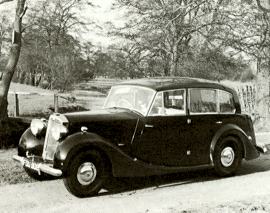 |
 |
Triumph 1800 Series 18T Saloon |
| |
Also see: Triumph Car Reviews | The History of Triumph |
| |
The Triumph Motor Co. Ltd was taken over by Standard and shortly afterwards two entirely new Triumph cars were announced, the 1800 Series 18T Saloon and Series 18TR Roadster. Both had a 1776-cc four-cylinder OHV engine. The Saloon featured very attractive 'razor edge' body styling. Production period: March 1946 to January 1949, then continued as 2000 (Renown). |
|
 |
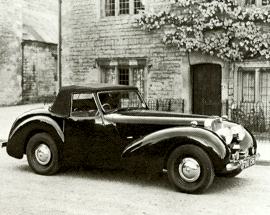 |
 |
Triumph 1800 Roadster Series 18 TR |
| |
Also see: Triumph Car Reviews | The History of Triumph |
| |
The Triumph 1800 Roadster, Series 18 TR, was mechanically similar to the 1800 Saloon (except 8 ft 4 in v. 9 ft wheelbase), but the 3/5-seat bodywork with its long low lines and curved rear end was in complete contrast. Both cars had a full-width bench-type front seat and steering-column gearchange. Note the triple windscreen wipers. Production period: March 1946 to October 1948. |
|
 |
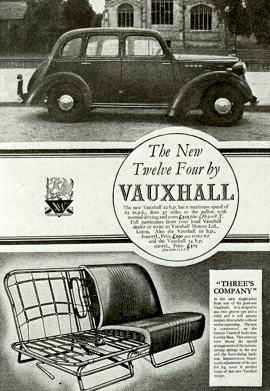 |
 |
Vauxhall Ten, Twelve and Fourteen |
| |
Also see: Vauxhall Car Reviews |
| |
The Vauxhall Motors' 1945/1946 production programme comprised Ten (Series HIY), Twelve (Series I and HIX) and Fourteen (Series JIB) Saloons. The Twelve was first produced (late 1945 to early 1946) with the 1940-style six-light body (pictured left), but from March 1946 the same four-light body was used as for the Ten. The engine was a 1442-cc 35-bhp Four. |
|
 |
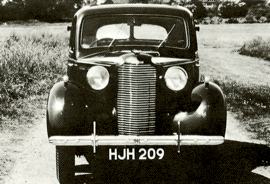 |
 |
Vauxhall Fourteen |
| |
Also see: Vauxhall Car Reviews |
| |
The Vauxhall Fourteen was a six-light saloon with 1781-cc 47·5-bhp six-cylinder engine and a longer wheelbase than the Ten and Twelve (8 ft 9 in v. 8 ft 1¾ in). It was the same as in 1940, but no longer had the chrome radiator grille surround. All models had OHV engines and Dubonnet type IFS. |
|
 |
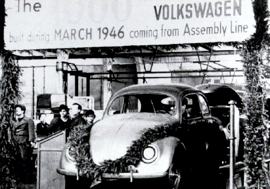 |
 |
Volkswagen Beetle |
| |
Also see: Volkswagen Car Reviews | The History of Volkswagen |
| |
Conceived in the 1930s where there was limited production, it was eventually put into mass production by a British army officer after the war. Mechanically not that remarkable, but the rear-engined, air-cooled Bug remained in production for more than 50 years. With some 21.5 million made, it's been one of the world's most popular cars ever. |
|
 |
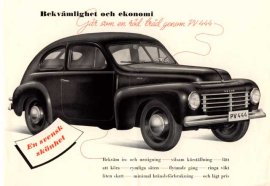 |
 |
Volvo PV 444 |
| |
Also see: Volvo Car Reviews | The History of Volvo |
| |
The PV444 was Volvo's first uni-body car. It was also the first Volvo in almost 20 years to come with a 4-cylinder engine. The first PV444s were powered by a 40 hp 1.4 liter inline-4 engine designated the B4B, with three main bearings, overhead valves, and a single downdraft carburetor. Late in 1955, an uprated version called the B14A was given twin side-draught 1½ in SU carburetors. |
|
 |
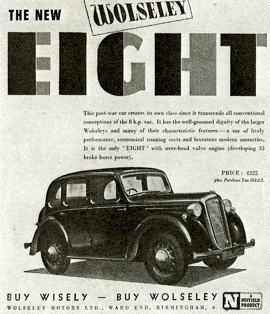 |
 |
Wolseley Eight |
| |
Also see: Wolseley Car Reviews | Wolseley Production Numbers 1940 - 1950 |
| |
The Wolseley Eight could be called a refined edition of the Morris Eight. It had an overhead valve version of the 918-cc Morris Eight engine, and with an output of 33 (v. 29·6) bhp was the most powerful (and only OHV) post-war 8 HP car. Naturally it also featured the traditional Wolseley radiator grille, incorporating the illuminated oval badge of the marque. It was produced only as four-door Saloon, from March 1946 until October 1948. |
|
 |
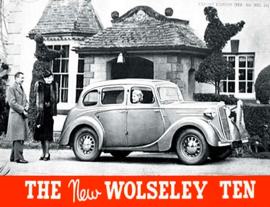 |
|
 |
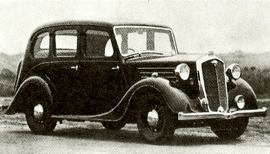 |
 |
Wolseley Twelve |
| |
Also see: Wolseley Car Reviews | Wolseley Production Numbers 1940 - 1950 |
| |
The Wolseley Twelve was very similar to its pre-war edition. It was known also as the 12/48 and was in production from December 1945 until October 1948. The engine was a 44-bhp 1548cc (69·5 x 102 mm) OHV Four. Wheelbase was 8 ft 2 in. Only saloon bodywork was offered. with or without sliding roof. |
|
 |
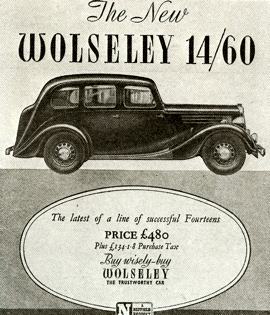 |
 |
Wolseley Fourteen 14/60 |
| |
Also see: Wolseley Car Reviews | The History of Wolseley (AUS Edition) |
| |
The Wolseley Fourteen, or 14/60, was similar to the Twelve but had 6½-in longer wheelbase and 1818cc (61·5 x 102 mm) six-cylinder OHV engine with two SU carburetors. Also available in 1946 were Ten and Eighteen (18/85) Saloons. These had 1140cc Four and 2321cc Six OHV engines respectively. |
|
 |
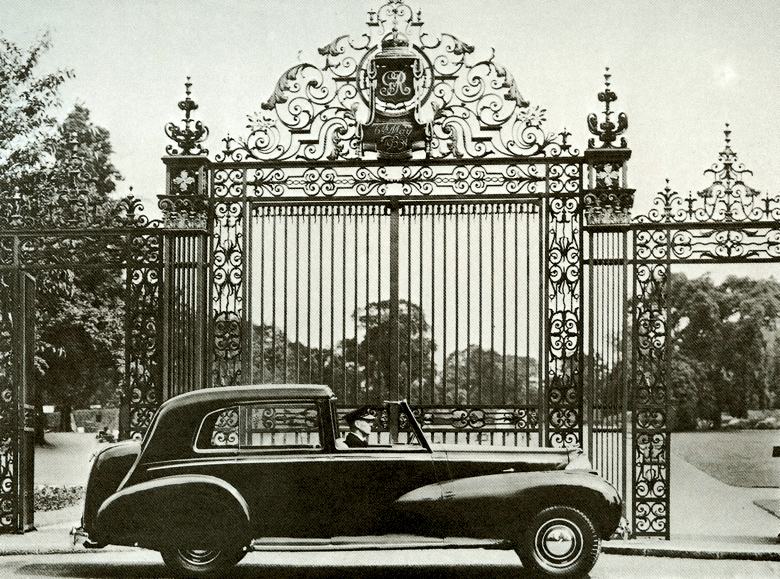
1946 Humber Pullman Dedanca De Ville by Mulliner. |
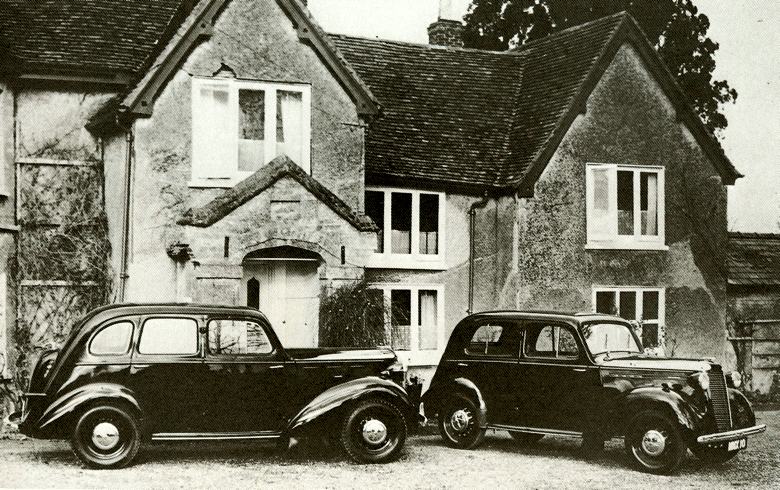
1946 Vauxhall Fourteen's. |
|
